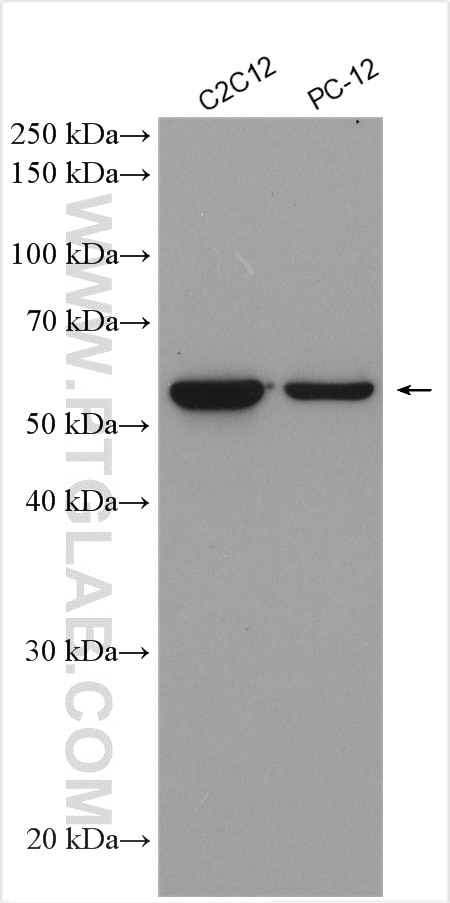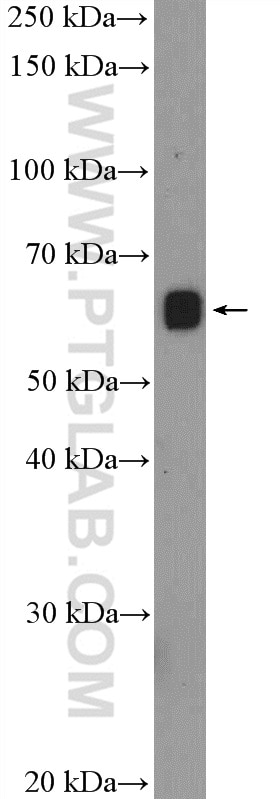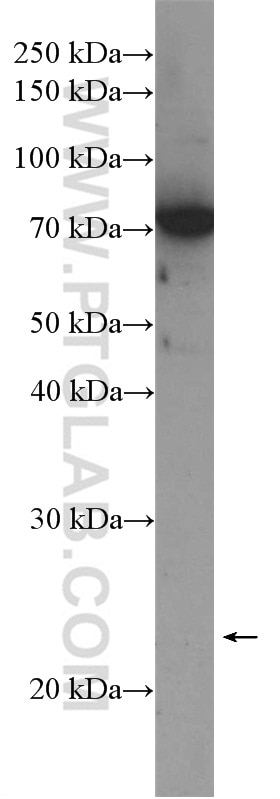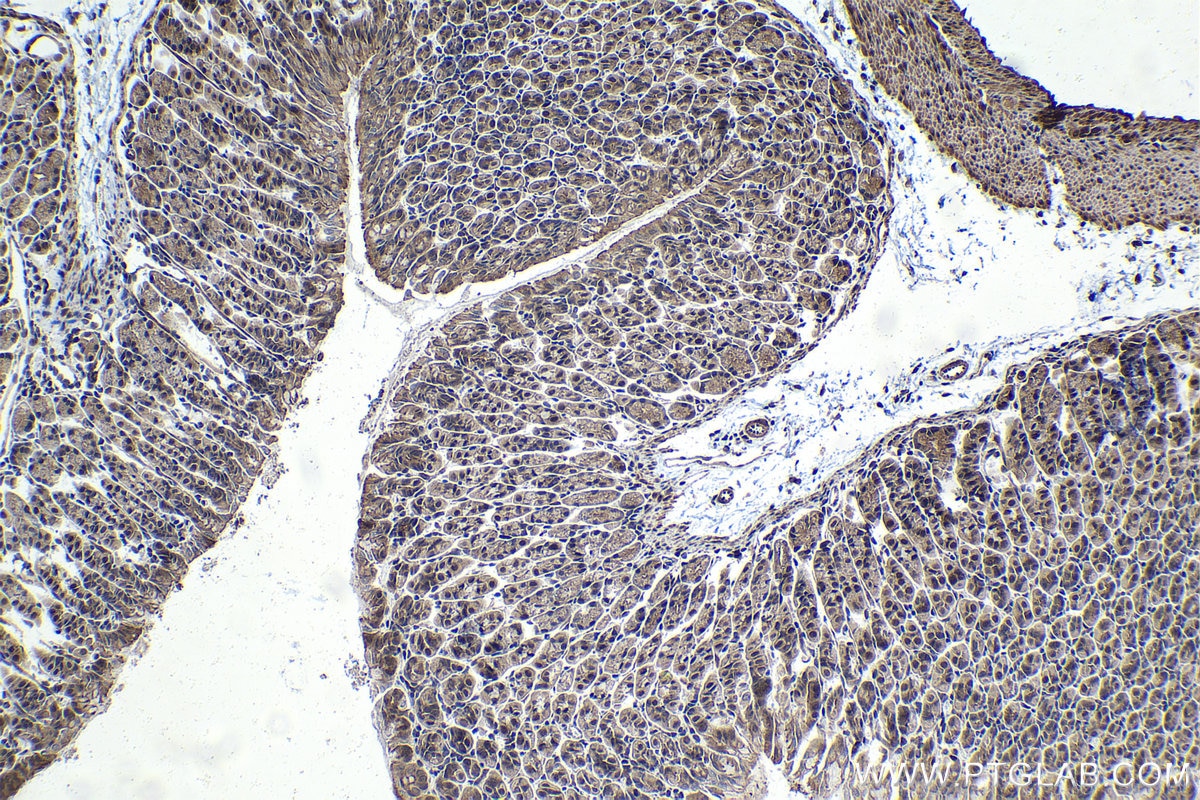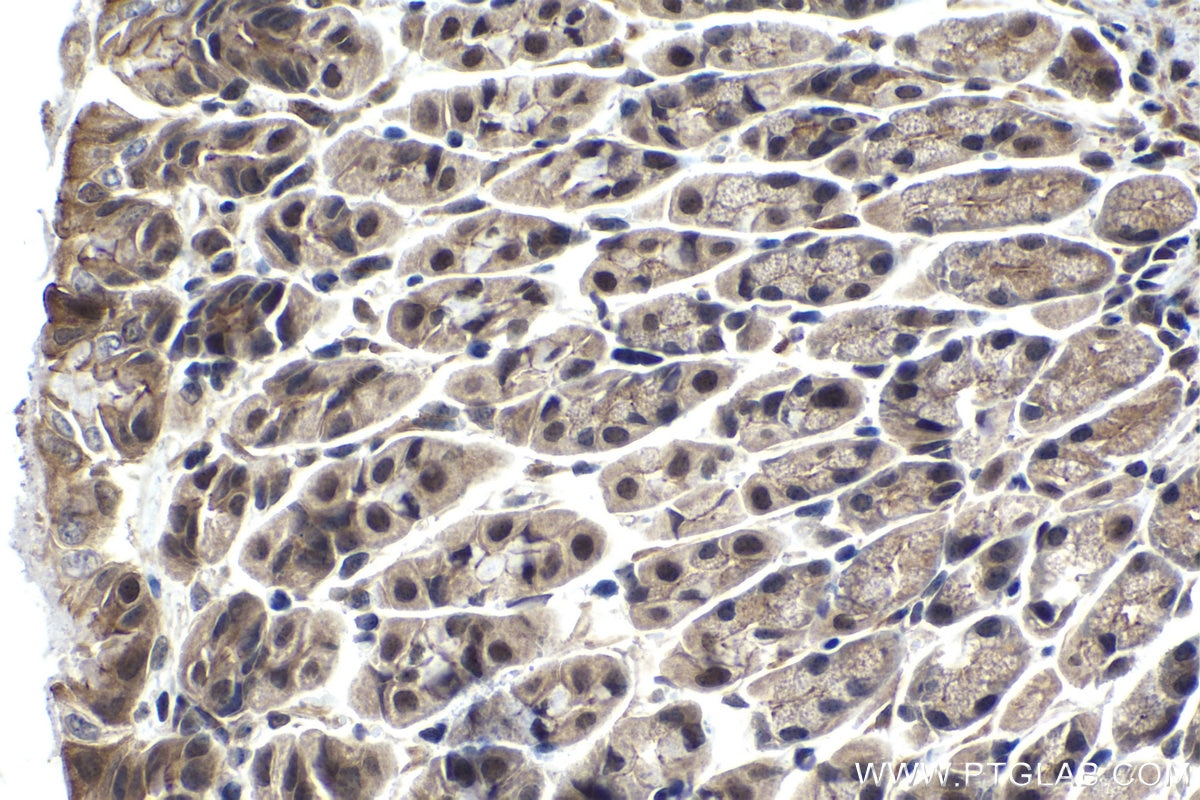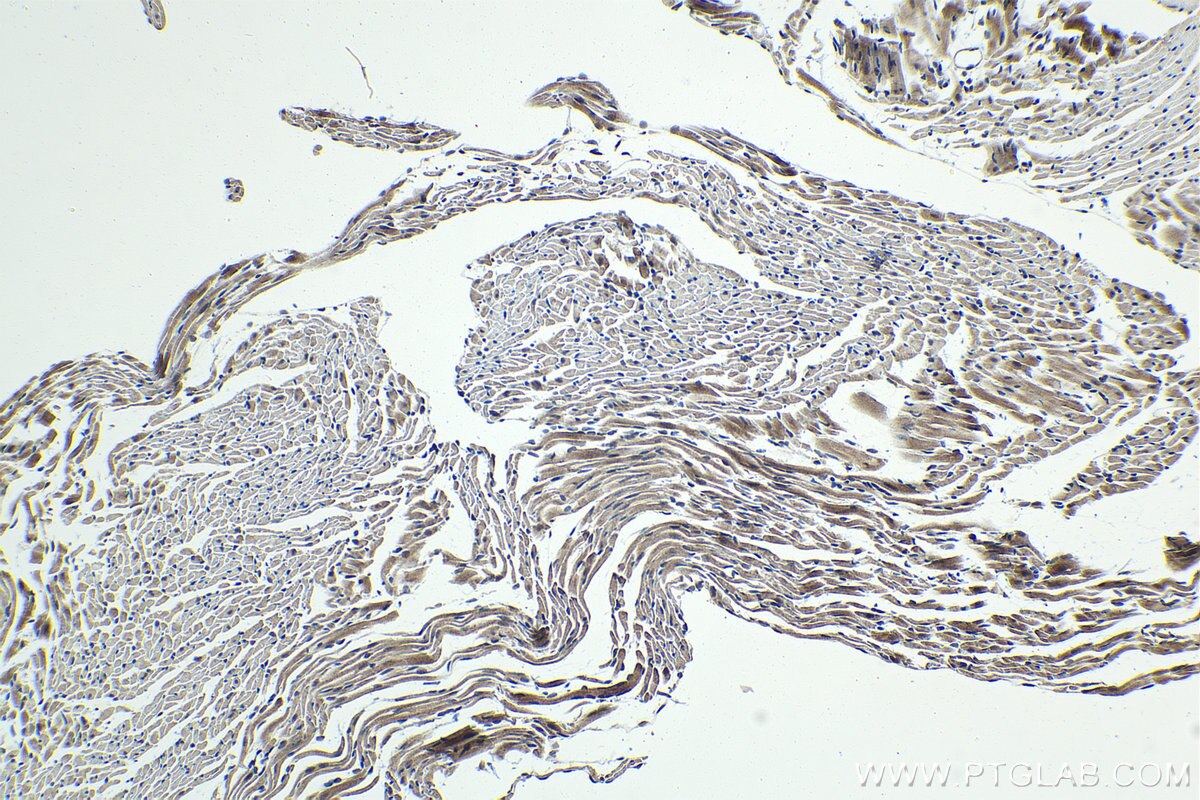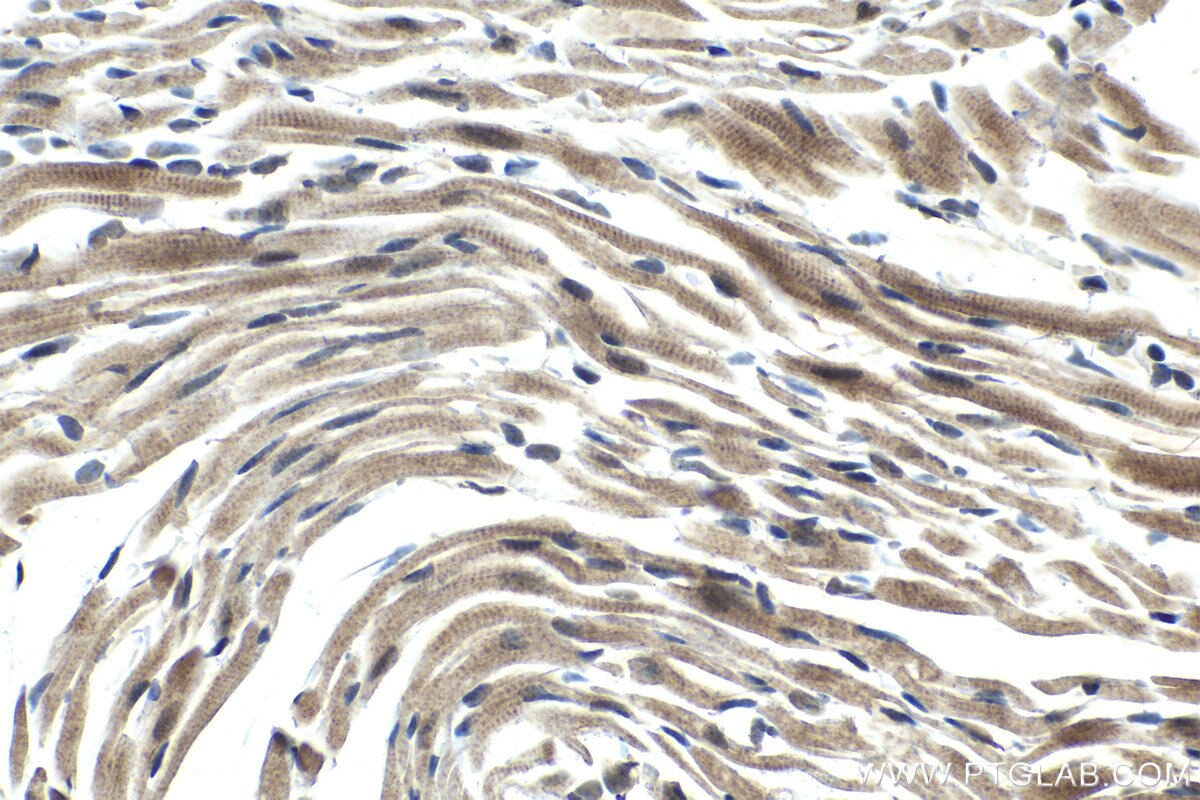Tested Applications
| Positive WB detected in | C2C12 cells, mouse heart tissue, PC-12 cells, mouse liver tissue |
| Positive IHC detected in | mouse stomach tissue, mouse heart tissue Note: suggested antigen retrieval with TE buffer pH 9.0; (*) Alternatively, antigen retrieval may be performed with citrate buffer pH 6.0 |
Recommended dilution
| Application | Dilution |
|---|---|
| Western Blot (WB) | WB : 1:1000-1:6000 |
| Immunohistochemistry (IHC) | IHC : 1:250-1:1000 |
| It is recommended that this reagent should be titrated in each testing system to obtain optimal results. | |
| Sample-dependent, Check data in validation data gallery. | |
Published Applications
| WB | See 4 publications below |
Product Information
15663-1-AP targets PHF1 in WB, IHC, ELISA applications and shows reactivity with human, mouse, rat samples.
| Tested Reactivity | human, mouse, rat |
| Cited Reactivity | human, mouse |
| Host / Isotype | Rabbit / IgG |
| Class | Polyclonal |
| Type | Antibody |
| Immunogen |
CatNo: Ag8094 Product name: Recombinant human PHF1 protein Source: e coli.-derived, PGEX-4T Tag: GST Domain: 1-351 aa of BC008834 Sequence: MAQPPRLSRSGASSLWDPASPAPTSGPRPRLWEGQDVLARWTDGLLYLGTIKKVDSAREVCLVQFEDDSQFLVLWKDISPAALPGEELLCCVCRSETVVPGNRLVSCEKCRHAYHQDCHVPRAPAPGEGEGTSWVCRQCVFAIATKRGGALKKGPYARAMLGMKLSLPYGLKGLDWDAGHLSNRQQSYCYCGGPGEWNLKMLQCRSCLQWFHEACTQCLSKPLLYGDRFYEFECCVCRGGPEKVRRLQLRWVDVAHLVLYHLSVCCKKKYFDFDREILPFTSENWDSLLLGELSDTPKGERSSKLLSALNSHKDRFISGREIKKRKCLFGLHARMPPPVEPPTGDGALTSF Predict reactive species |
| Full Name | PHD finger protein 1 |
| Calculated Molecular Weight | 567 aa, 62 kDa |
| Observed Molecular Weight | 62-70 kDa |
| GenBank Accession Number | BC008834 |
| Gene Symbol | PHF1 |
| Gene ID (NCBI) | 5252 |
| RRID | AB_2878164 |
| Conjugate | Unconjugated |
| Form | Liquid |
| Purification Method | Antigen affinity purification |
| UNIPROT ID | O43189 |
| Storage Buffer | PBS with 0.02% sodium azide and 50% glycerol, pH 7.3. |
| Storage Conditions | Store at -20°C. Stable for one year after shipment. Aliquoting is unnecessary for -20oC storage. 20ul sizes contain 0.1% BSA. |
Background Information
Background
Plant homeodomain finger protein 1 (PHF1) has a specific role in histone modification and in non-homologous end joining. It is a human homolog of the Drosophila protein Polycomb-like protein.
PHF1 acts by binding to H3K36me3, a mark for transcriptional activation, and recruiting the PRC2 complex: it is however unclear whether recruitment of the PRC2 complex to H3K36me3 leads to enhance or inhibit H3K27me3 methylation mediated by the PRC2 complex. PHF1 regulates also p53/TP53 stability.
What is the molecular weight of PHF1?
62 kDa
What is the structure of PHF1?
PHF1 contains two zinc finger-like plant homeodomain (PHD) sequences, a Cys4-His-Cys3 motif that is able to recognize and modify histone tails, making it important in epigenetic regulation (PMID: 18682256). It also contains a Tudor domain, a sequence of approximately 60 amino acids that has also been shown to bind to methylated histone tails (PMID: 16601153). The sequence of PHF1 is similar to the Polycomb family of genes in Drosophila, chromatin remodeling genes that act in embryogenesis.
What is the role of PHF1?
PHF1 has a key role in histone modification. It acts by binding to the histone H3K36me3, a lysine methylation of histone H3 that is a mark for transcriptional activation (PMID: 17189264). PHF1 then recruits Polycomb repressive complex 2 (PRC2) to mark genes for repression. These epigenetic chromatin modifiers are important in cancer development, gene silencing, and stem cell maintenance.
PHF1 is also found to be recruited to double-strand breaks in DNA and plays an important part in the repair in non-homologous end joining (PMID: 18385154), the main DNA repair process in which ends of DNA are ligated without a homologous template. Interacting with proteins involved in DNA damage response, PH1 appears to have a role beyond the polycomb function (PMID: 18385154).
Protocols
| Product Specific Protocols | |
|---|---|
| IHC protocol for PHF1 antibody 15663-1-AP | Download protocol |
| WB protocol for PHF1 antibody 15663-1-AP | Download protocol |
| Standard Protocols | |
|---|---|
| Click here to view our Standard Protocols |
Publications
| Species | Application | Title |
|---|---|---|
Mol Cell A Family of Vertebrate-Specific Polycombs Encoded by the LCOR/LCORL Genes Balance PRC2 Subtype Activities. | ||
Mol Cell PALI1 promotes tumor growth through competitive recruitment of PRC2 to G9A-target chromatin for dual epigenetic silencing | ||
Cell Death Dis Dexmedetomidine improves the circulatory dysfunction of the glymphatic system induced by sevoflurane through the PI3K/AKT/ΔFosB/AQP4 pathway in young mice | ||
Mol Cancer A multidimensional recommendation framework for identifying biological targets to aid the diagnosis and treatment of liver metastasis in patients with colorectal cancer |

